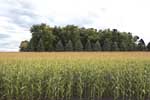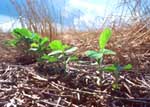|
| |
 
The Natural Resources Conservation Service —
Helping People Help the Land.
Subscribe to NRCS This Week
| NRCS This Week Articles Index | NRCS
This Week Archives |
Contact Us |
Where to Get Information
|
eNotes from
NACD |
 TSP Express
(Requires Adobe Acrobat.) TSP Express
(Requires Adobe Acrobat.)

Alaska
Delta Producers Explore Use of Anaerobic Digesters
NRCS engineers Jeff Oatley and Brett Nelson joined West National Technology
Support Center Environmental Engineer Charles Zuller in the Delta Junction area
last week to visit with producers about anaerobic digester technology. The group
came together at the request of district conservationist Catherine Hadley.
Florida
 These
items require
Windows Media Player These
items require
Windows Media Player
 USDA has awarded grants to help with grazing lands — Florida received two of
them.
USDA has awarded grants to help with grazing lands — Florida received two of
them.
GPS collars are helping to better understand the behavior of Florida's
livestock.
Louisiana
 NRCS
Golden Meadow Plant Materials Center donates trees to diverse organizations
ranging from Grand Isle Port Commission to the Audubon Zoo NRCS
Golden Meadow Plant Materials Center donates trees to diverse organizations
ranging from Grand Isle Port Commission to the Audubon Zoo
New Hampshire
 NRCS
Earth Team Volunteer Honored NRCS
Earth Team Volunteer Honored
Dr. Alan P. Ammann, retired New Hampshire NRCS biologist now Earth Team
volunteer, was recently awarded the prestigious
2006 National Wetlands
Award for Conservation and Restoration.
Links...
Read the Portsmouth Herald story: Boyhood Loss Launches Lifetime Crusade
Montana
 GLCI
in Montana Meets the "Challenge" GLCI
in Montana Meets the "Challenge"
Chairman of the Blackfoot Challenge Jim Stone and Powell County weed district
coordinator Jason Smith accept a
Grazing Lands Conservation Initiative (GLCI) grant check to the Blackfoot Challenge to fund a
noxious weed project. The check was presented by USDA Undersecretary for
Natural Resources and the Environment Mark Rey as Montana NRCS State
Conservationist Dave White looks on. (see story below)
Connect to
NRCS' State
News,
Newsroom, and
News Releases!

 USDA
Awards $4.1 Million in Grants to Manage and Control Invasive Species Affecting
Grazing Lands USDA
Awards $4.1 Million in Grants to Manage and Control Invasive Species Affecting
Grazing Lands
USDA Under Secretary for Natural Resources and Environment Mark Rey has awarded
$4.1 million to fund 27 projects in 20 states to manage and control invasive
plants, animals or insects that adversely affect private and tribal grazing
lands. Approved grantees include five county weed control and management
districts, five resource conservation and development councils, three
conservation districts, three foundations and non-profit organizations, three
Federally-recognized Native American tribes or organizations that assist them,
and two state departments of agriculture.
Links...
NRCS
news release "USDA Awards $4.1 Million in Grants to Manage and Control Invasive
Species Affecting Grazing Lands" (July 28, 2006)
State listing of
Grazing Land Conservation Initiative grants (PDF)
Grazing Lands Conservation
Initiative Web page
 USDA
Announces Amendments to Interim Final Rule and Public Comment Period for the
Farm and Ranch Lands Protection Program USDA
Announces Amendments to Interim Final Rule and Public Comment Period for the
Farm and Ranch Lands Protection Program
USDA Under Secretary for Natural Resources and Environment Mark Rey has
announced the release of an amended interim final rule for the Farm and Ranch
Lands Protection Program with a request for public comment. Public comments on
the rule will be accepted for 60 days from the date the rule appears in the
Federal Register. USDA proposes that land eligibility criteria should focus on
preserving the nation’s most critical farm and ranch lands resources.
Links...
 news
release
"USDA Announces Amendments to Interim Final Rule and Public Comment Period for
the Farm and Ranch Lands Protection Program" (July 28, 2006) news
release
"USDA Announces Amendments to Interim Final Rule and Public Comment Period for
the Farm and Ranch Lands Protection Program" (July 28, 2006)
Farm and Ranch Lands
Protection Program

 SQNTD
Team Developments SQNTD
Team Developments
Crop residues perform many important ecosystem functions such as erosion
protection, increasing soil organic matter, and nutrient storage and cycling
that ultimately improve soil quality. As many of NRCS conservation practices and goals
are achieved by leaving and maintaining residues on the soil surface, any
residue removal activities should be carefully considered and offset by
conservation practices such as cover crops and crop rotation.

Click here for
NRCS Directives for the week of July 30, 2006
The U.S. Department of Agriculture (USDA) prohibits discrimination in all its
programs and activities on the basis of race, color, national origin, age,
disability, and where applicable, sex, marital status, familial status, parental
status, religion, sexual orientation, genetic information, political beliefs,
reprisal, or because all or a part of an individual's income is derived from any
public assistance program. (Not all prohibited bases apply to all programs.)
Persons with disabilities who require alternative means for communication of
program information (Braille, large print, audiotape, etc.) should contact
USDA's TARGET Center at (202) 720-2600 (voice and TDD).
To file a complaint of discrimination write to USDA, Director, Office of Civil
Rights, 1400 Independence Avenue, S.W., Washington, D.C. 20250-9410 or call
(800) 795-3272 (voice) or (202) 720-6382 (TDD). USDA is an equal opportunity
provider and employer.
| | |


